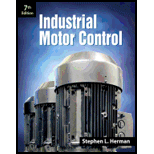
Industrial Motor Control
7th Edition
ISBN: 9781133691808
Author: Stephen Herman
Publisher: Cengage Learning
expand_more
expand_more
format_list_bulleted
Concept explainers
Question
Chapter 42, Problem 2RQ
To determine
The reason when the inductions motor that are intended to be controlled by varying voltage contain high impedance stator windings.
Expert Solution & Answer
Want to see the full answer?
Check out a sample textbook solution
Students have asked these similar questions
Problem 1 (30 Points)
Consider the following 2 scenarios. In scenario 1, a mass m slides on a cylindrical surface of radius R. In
scenario 2, a mass m hangs at the end of a thin massless rod of length R. In both scenarios, there is no
friction either on the surface (scenario 1), or at the pivot point of the pendulum (scenario 2). Also in
both scenarios, there is one generalized coordinate, .
R
Scenario 1
R
m
R
g
Scenario 2
m
HINT: In both scenarios, it is much easier to choose your datum for potential energy as the center of the
bowl (scenario 1), or the pivot point of the pendulum (scenario 2).
Part I
a) Determine the Lagrangian for each system. DO NOT FIND THE EQUATIONS OF MOTION (5 points)
b) What can you say about the systems based on the Lagrangian? (2 points)
c) Solve for the equations of motion for both systems. (8 points)
Part II
Now, for scenario 1, introduce an additional coordinate and treat it as a nonholonomic system to
determine the normal force acting on the mass.
a)…
Consider 0.65 kg of N2 at 300 K, 1 bar contained in a rigid tank connected by a valve to another rigid tank holding 0.3 kg of CO2 at 300 K, 1 bar. The valve is opened and gases are allowed to mix, achieving an equilibrium state at 290 K. Determine: (a) the volume of each tank, in m³. (b) the final pressure, in bar. (c) the magnitude of the heat transfer to or from the gases during the process, in kJ. (d) the entropy change of each gas and of the overall system, in kJ/K.
(Read Image) (Answer: ω = 1.10 rad/sec CW)
Chapter 42 Solutions
Industrial Motor Control
Knowledge Booster
Learn more about
Need a deep-dive on the concept behind this application? Look no further. Learn more about this topic, mechanical-engineering and related others by exploring similar questions and additional content below.Similar questions
- What is the configuration of the control loop if steam must be shut down in case of a problem? (I found this question on the internet and was wondering what the answer is) A.Valve is fail open, PIC is direct-acting, TIC is reverse acting, and controller algorithm is feed-forwarding.B. Valve is fail open, PIC is reverse-acting, TIC is direct acting, and controller algorithm is cascade.C. Valve is fail closed, PIC is direct-acting, TIC is reverse acting, and controller algorithm is feed-forward.D. Valve is fail closed, PIC is reverse-acting, TIC is reverse acting, and controller algorithm is cascade.arrow_forwardWhat is the procedure to replace the input bellows?(I found this question on the internet and was wondering what the correct answer is out of interest) Remove tubing, old bellows and flapper assembly, install new bellows, connect tubing, install flapper assembly, then calibrate the positioner.Remove tubing, old bellows and cam, install new bellows, connect tubing, install cam, then calibrate the positioner.C. Remove tubing and old bellows, align the quadrant beam, install new bellows and connect tubing, then calibrate the positioner.D. Remove tubing and old bellows, install new bellows and connect tubing, align the quadrant beam, then calibrate the positioner.arrow_forwardGiven the following information: (I found this question on the internet and was wondering what the correct answer is) Firing rate demand = 20% Fuel air ratio = 2:1 Fuel flow = 20% Minimum air flow setting = 5% What is the set point for the air flow controller? 5%B. 10%C. 25%D. 40%arrow_forward
- . Where is a dew point analyzer installed to measure instrument air?(I found this question on the internet and am wondering what the correct answer is) A. AB. BC. CD. Darrow_forwardThe piston at the bottom of the stroke is 0% open. Which adjustment will change the zero setting to 5% open? ( I found this sample question on the internet and was wondering what the correct answer is out of interest) A.Slide component 2 towards the pivotB. Slide component 2 away from the pivot.C. Increase spring tension using adjustment 1.D. Decrease spring tension using adjustment 1.arrow_forward(read image) (Answer: vA = 4.57 ft/sec)arrow_forward
arrow_back_ios
SEE MORE QUESTIONS
arrow_forward_ios
Recommended textbooks for you
 Understanding Motor ControlsMechanical EngineeringISBN:9781337798686Author:Stephen L. HermanPublisher:Delmar Cengage Learning
Understanding Motor ControlsMechanical EngineeringISBN:9781337798686Author:Stephen L. HermanPublisher:Delmar Cengage Learning Electrical Transformers and Rotating MachinesMechanical EngineeringISBN:9781305494817Author:Stephen L. HermanPublisher:Cengage Learning
Electrical Transformers and Rotating MachinesMechanical EngineeringISBN:9781305494817Author:Stephen L. HermanPublisher:Cengage Learning Refrigeration and Air Conditioning Technology (Mi...Mechanical EngineeringISBN:9781305578296Author:John Tomczyk, Eugene Silberstein, Bill Whitman, Bill JohnsonPublisher:Cengage Learning
Refrigeration and Air Conditioning Technology (Mi...Mechanical EngineeringISBN:9781305578296Author:John Tomczyk, Eugene Silberstein, Bill Whitman, Bill JohnsonPublisher:Cengage Learning

Understanding Motor Controls
Mechanical Engineering
ISBN:9781337798686
Author:Stephen L. Herman
Publisher:Delmar Cengage Learning

Electrical Transformers and Rotating Machines
Mechanical Engineering
ISBN:9781305494817
Author:Stephen L. Herman
Publisher:Cengage Learning

Refrigeration and Air Conditioning Technology (Mi...
Mechanical Engineering
ISBN:9781305578296
Author:John Tomczyk, Eugene Silberstein, Bill Whitman, Bill Johnson
Publisher:Cengage Learning